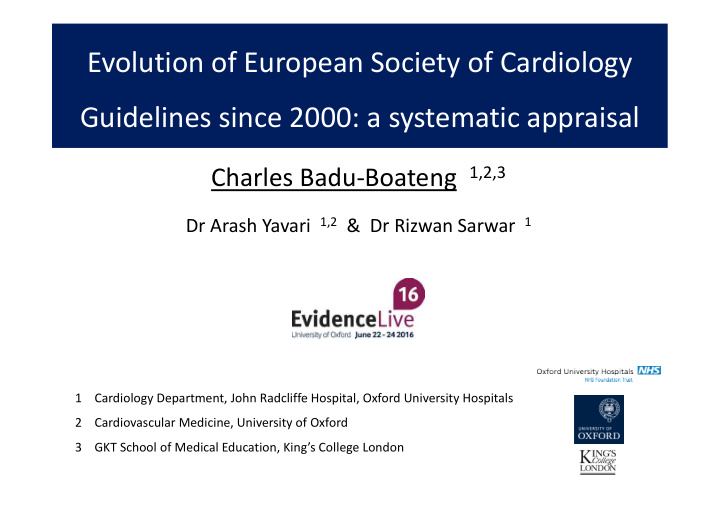



Evolution of European Society of Cardiology Guidelines since 2000: a systematic appraisal Charles Badu-Boateng 1,2,3 Dr Arash Yavari 1,2 & Dr Rizwan Sarwar 1 1 Cardiology Department, John Radcliffe Hospital, Oxford University Hospitals 2 Cardiovascular Medicine, University of Oxford 3 GKT School of Medical Education, King’s College London
Declarations • No conflicts of interest • No funding to declare
Introduction • WHO data: cardiovascular diseases (CVDs) responsible for 31% of all deaths worldwide • European Society of Cardiology (ESC) – association of 95,000 professionals – mission: ‘ to reduce the burden of CVD in Europe ’ • ESC produces Clinical Practice Guidelines to facilitate this mission http://www.who.int/mediacentre/factsheets/fs317/en/
ESC Guidelines • Currently 24 active guidelines • Periodically updated by ‘selected experts’ to clarify areas of consensus and disagreement • Extensive review by the Committee of Practice Guidelines and external experts • Publication of guidelines – in European Heart Journal – free online – free app
Recommendations within guidelines • Strength of recommendations within guidelines are weighed and graded according to pre-defined scales – Class of Recommendation – Level of Evidence
Class of recommendation
Level of evidence
Previous work • Prof Darrel Francis (Imperial College London) – Abstract only 2014 – ESC guidelines 2000-13 – Not assessed class of recommendations – Levels of Evidence • 18% LoE A • 32% LoE B • 50% LoE C Sau, Cole, Cook, Shun-Shin, Francis (2014) Systematic analysis of European Society of Cardiology guidelines: what do we actually base our practice on? Heart , 100 (Suppl 3): A110.
Aim • To evaluate the recommendations within ESC guidelines from 2000-2015
Methods • Guidelines – retrieved all guidelines from ESC 2000-2015 – current and historical • Every recommendation was identified manually – Class of Recommendation (CoR) I, II, III – Level of Evidence (LoE) A, B, C http://www.escardio.org/Guidelines-&-Education/Clinical-Practice-Guidelines/ESC-Clinical-Practice-Guidelines-list/listing
Results • 2000-2015 – 24 current guidelines – 49 inactive guidelines • 3386 current recommendations
Class of Recommendations Class I Class II Class III Recommendations Percentage 2000 2002 2004 2006 2008 2010 2012 2014 2016 2000 2002 2004 2006 2008 2010 2012 2014 2016 • 41% current recommendations Class II No statistically significant changes in %ages over 15 years •
Level of Evidence Level of Evidence A Level of Evidence B Level of Evidence C Recommendations 3 Percentage 2000 2002 2004 2006 2008 2010 2012 2014 2016 2000 2002 2004 2006 2008 2010 2012 2014 2016 52% of current recommendations were of Level C • No statistically significant changes in %ages over 15 years •
Summary of 24 current guidelines Level of Evidence 1000 A B 800 C 600 400 200 0 I II III Class of Recommendations
Conclusions • 2000 to 2015: – 20-fold increase in recommendations – 41% recommendations CoR II (unlike definitive CoR I or III) – 52% recommendations LoE C – ….too many recommendations which are not based on high level evidence and not definitive • There is a need to improve LoE underpinning current ESC guidelines to promote definitive guidance
Acknowledgement • Dr Rizwan Sarwar • Dr Arash Yavari
End
Results summary table `LoE – A LoE - B LoE- C LoE - U Total CoR - I 415 498 787 38 1738 CoR - II 87 474 839 16 1416 CoR - III 54 83 149 11 297 CoR - U 43 58 37 0 138 599 1113 1812 65 3589 LoE - A LoE - B LoE- C LoE - U CoR - I 12% 14% 22% 1% 48% CoR - II 2% 13% 23% 0% 39% CoR - III 2% 2% 4% 0% 8% CoR - U 1% 2% 1% 0% 4% 17% 31% 50% 2% 100%
Recommend
More recommend